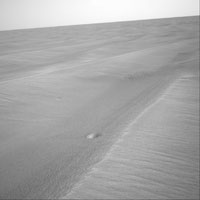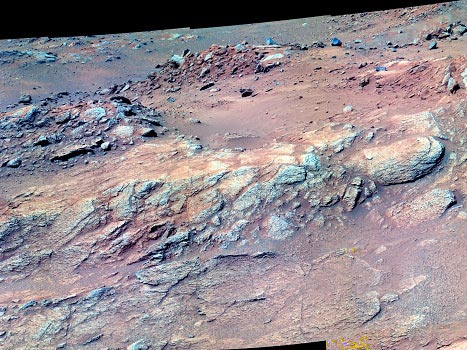

The final defining moment was when NASA, in desperation to see their only remaining project saved, went to the Air Force for its blessing. NASA asked that the AF place all of their future launches on the shuttle instead of their current expendable launchers (like the Titan II), in return for which they would no longer have to continue spending money upgrading those designs -- the shuttle would provide more than enough capability.
Image Below form NASA: Tiny Craters on Meridiani Planum These two craters, each smaller than a foot in diameter and less than one-half inch deep, were found intact by NASA's Mars rover Opportunity. Image credit: NASA/JPL

Catherine Coleman
participated at the analysis of the Long Duration Exposure Facility (LDEF) experiment launched with STS-41-C and retrieved with STS-32. In 1991 she received doctorate in polymer science and engineering from the University of Massachusetts. She was selected by NASA in 1992 to become a mission specialist astronaut. She took part in two space shuttle missions so far. In 1995 she was member of the STS-73 crew on the scientific mission USML-1 with experiments including biotechnology, combustion science and the physics of fluids. She also trained for the mission STS-83 to be the backup for Donald Thomas, however as he recovered on time she did not fly that mission. STS-93 was Catherine Coleman second space flight. On that mission the Chandra X-ray Observatory was sent to orbit.
Barbara Morgan
R. Morgan (November 28, 1951 - ) is the first NASA Educator Astronaut, scheduled to fly on STS-118. Morgan trained to fly on the ill-fated STS-51-L mission of Space Shuttle Challenger as backup to Christa McAuliffe and has remained involved in the space program since then. Personal Data Born November 28, 1951, in Fresno, California. Married to Clay Morgan of McCall, Idaho. They have two sons. She is a classical flutist who also enjoys jazz, literature, hiking, swimming, cross-country skiing, and her family. Her parents are Dr. and Mrs. Jerry Radding. Her mother-in-law is Mrs. Clay Morgan. Education Hoover High School, Fresno, California, 1969; B.A., Human Biology, with distinction, Stanford University, 1973; Teaching Credential, College of Notre Dame, Belmont, California, 1974. Teaching Experience Morgan began her teaching career in 1974 on
ALT
Tim Finn and Liam O'Maonlai. ALT is also an abbreviation for Assistant Language Teacher, the job title of people on the JET Programme. ALT was also an acronym by the NASA for the Approach and Landing Tests of the Space Shuttle in 1976. ALT can mean alternative lengthening of telomeres, a mechanism (other than telomerase) that cells use to maintain telomere length.
Whilst the shuttle has been a reasonably successful launch vehicle, it had been unable to meet its goals of radically reducing flight launch costs, as each flight costs on the order of $500 million rather than initial projections of $10 to $20 million. Although the design is radically different than the original concept, the project was still supposed to meet the upgraded AF goals as well as be much cheaper to fly in general. What went wrong? One issue appears to be inflation. During the 1970s the US suffered from the worst inflation in modern history, driving up costs about 200% by 1980. In contrast, the rate between 1990 and 2000 was only 34% in total. This has the effect of magnifying the development costs of the shuttle tremendously. However this doesn't explain the high costs of the continued operations of the shuttle. Even accounting for inflation the launch costs on the original estimates should be about $100 million today. To explain this you have to look at the operational details of maintaining and servicing the shuttle fleet, which have turned out to be tremendously more expensive than anticipated. When originally conceived the shuttle was to operate similar to an airliner. After landing the Orbiter would be checked out and start "mating" to the rest of the system (the ET and SRBs) and be ready for launch in as little as two weeks. Instead this turnaround process in fact takes months. This is due, in turn, to the continued "upgrading" of the inspection process as a result of hardware decisions made to reduce short-term development costs which resulted in higher maintenance requirements which where exacerbated by the fallout from the loss of Challenger. Even simple tasks now require unbelievable amounts of paperwork. This paperwork results from the fact that, unlike current expendable launch vehicles, the Space Shuttle is manned and has no escape systems to speak of and therefore any accident which would result in the loss of booster would also result in the loss of the crew which is, of course, unacceptable. Because loss of crew is unacceptable, the primary focus of the shuttle program is to return the crew to earth safely, which can conflict with other goals, namely to launch satellites cheaply. Furthermore, because there are cases where there are no abort modes, no potential way to prevent failure from becoming critical, many pieces of hardware simply must function perfectly and so must be carefully inspected before each flight. The result is a massively inflated manpower bill. There are 25,000 workers in shuttle operations (perhaps an older number), so simply multiply any figure that you choose for an average annual salary, divide by six (or 4 or 7...launches per year), and there you have it. The lessons of the shuttle have been seen as different depending on who you ask. In general, however, future designers look to systems with only one stage, automated checkout, and in some cases, overdesigned (more durable) low-tech systems. Perhaps the most annoying aspect of the shuttle system is to consider the Air Force participation. While the blame rests solely at the feet of NASA for getting them involved in the first place, it was the Air Force requirements that drove the system to be as complex and expensive as it is today. Ironically neither NASA nor the Air Force got the system they wanted or needed, and the Air Force eventually threw in the towel and returned to their older launch systems and abandoned their Vandenburg shuttle launch plans. The capabilities which most seriously hobbled the Shuttle system, namely the 65,000 payload, large payload bay, and 1000 mile cross-range, have in fact, except for the payload bay, never been used.
HAL/S John F. Kennedy Space Center Methuselah in False Color 5/24/05
A number of designs were proposed, but many of them were complex and varied widely in their systems. An attempt to re-simplify was made in the form of the "DC-3" by one of the few people left in NASA with the political clout to pull it off, Maxime Faget, who had designed the Mercury capsule, among others. The DC-3 was a small craft with a 20,000lbs (or less) payload, a four-man crew, and limited manuverability. At a minimum, the DC-3 provided a baseline "workable" (but not terribly advanced) system by which other systems could be compared for price/performance tradeoffs.The Shuttle in retrospect
computer language, best known for its use in the Space Shuttle. It was written by Intermetrics in the 1970s for NASA. HAL/S is written in a dialect of PL/I known as XPL The three key factors in writing the language were reliability, efficiency, and machine-independence. The language is designed to allow tasks such as performing aerospace related vector/matrix arithmetic to be accomplished in a way that is easily understandable to people who have studied the subject. HAL/S is written without functions (such as GOTO in BASIC) that are known to be the cause of many errors. There are no abreviations for keywords, and keywords are all reserved so that they cannot also be used as variables. Considerations such as this are designed to reduce the chances of errors occurring, and also
John F. Kennedy Space Center The John F. Kennedy Space Center (KSC) is the NASA space vehicle launch facility (spaceport) at Cape Canaveral on Merritt Island in Florida, United States. The site is midway between Miami and Jacksonville, Florida. It is 55 km long and around 10 km wide, covering 56,700 hectares. Around 17,000 people work at the site. There is a visitor center and public tours and KSC is a major tourist destination for visitors to Florida. Because much of KSC is off limits to development, the site also serves as an important wildlife sanctuary. Operations are currently controlled from Launch Complex 39, the location of the Vehicle Assembly Building. 6 km to the east of the assembly building are the two launch pads. 8 km south
